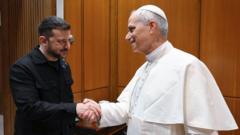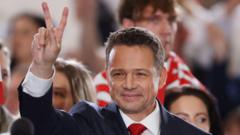The conclave enters its second day with cardinals casting votes, aiming for a new leader for the Roman Catholic Church. Predictions suggest a potentially prolonged process given the diverse composition and differing priorities among the electors.**
Conclave Continues as Roman Catholic Church Seeks New Leader**

Conclave Continues as Roman Catholic Church Seeks New Leader**
Second day of deliberations as cardinals await consensus on pope successor amidst significant challenges.**
In Vatican City, the papal conclave resumes for a second day as 133 cardinals convene in their quest to elect Pope Francis’ successor. Following a fruitless first day of discussions, the cardinals gathered early Thursday morning to resume their voting process. With a two-thirds majority needed to select the next pope, many in attendance are aware that the choice will significantly impact the future direction of the Catholic Church.
The conclave is shrouded in secrecy, devoid of technology and external communication. Cardinal electors are sworn to confidentiality, adhering strictly to traditions to ensure the sanctity of the voting process. Notably, Pope Francis’ passing in April has escalated the urgency of this conclave, marking the first in a decade. Observers acknowledge a complex landscape: The Church grapples with financial difficulties, ongoing challenges regarding sexual abuse scandals, and internal divisions between progressive and conservative factions.
This conclave is particularly notable, with many cardinals meeting each other for the first time, prompting discussions regarding their approach towards a potential election. Victor Emmanuel, a church historian, noted that this could create a more fragmented selection process than in previous conclaves. Current speculation points toward prominent candidates, including Cardinal Pietro Parolin, who served under Francis, and Cardinal Luis Antonio Tagle from the Philippines.
The cardinals follow a meticulous voting system, with multiple ballots conducted each day until consensus is achieved. After voting sessions, the ballots are burned, producing smoke signals that announce the outcome—black smoke for no pope, white for a new leader. As anticipation builds, public interest remains high; crowds in St. Peter’s Square grow expectant, although the final decision could take time.
Historical precedent shows that conclaves can vary significantly in duration, from just two days to several years in some cases. Experts suggest that internal dynamics and the diverse array of new cardinals could lengthen this conclave, with varied opinions on how quickly consensus might emerge. Cardinal Timothy M. Dolan expressed concern that the process could extend longer than previous conclaves due to unfamiliarity among many of the electors.
As the cardinals prepare for several rounds of voting today, the world watches intently. Many await the smoke signals that will reveal whether a new leader for the world’s 1.4 billion Catholics will emerge as the conclave unfolds.
The conclave is shrouded in secrecy, devoid of technology and external communication. Cardinal electors are sworn to confidentiality, adhering strictly to traditions to ensure the sanctity of the voting process. Notably, Pope Francis’ passing in April has escalated the urgency of this conclave, marking the first in a decade. Observers acknowledge a complex landscape: The Church grapples with financial difficulties, ongoing challenges regarding sexual abuse scandals, and internal divisions between progressive and conservative factions.
This conclave is particularly notable, with many cardinals meeting each other for the first time, prompting discussions regarding their approach towards a potential election. Victor Emmanuel, a church historian, noted that this could create a more fragmented selection process than in previous conclaves. Current speculation points toward prominent candidates, including Cardinal Pietro Parolin, who served under Francis, and Cardinal Luis Antonio Tagle from the Philippines.
The cardinals follow a meticulous voting system, with multiple ballots conducted each day until consensus is achieved. After voting sessions, the ballots are burned, producing smoke signals that announce the outcome—black smoke for no pope, white for a new leader. As anticipation builds, public interest remains high; crowds in St. Peter’s Square grow expectant, although the final decision could take time.
Historical precedent shows that conclaves can vary significantly in duration, from just two days to several years in some cases. Experts suggest that internal dynamics and the diverse array of new cardinals could lengthen this conclave, with varied opinions on how quickly consensus might emerge. Cardinal Timothy M. Dolan expressed concern that the process could extend longer than previous conclaves due to unfamiliarity among many of the electors.
As the cardinals prepare for several rounds of voting today, the world watches intently. Many await the smoke signals that will reveal whether a new leader for the world’s 1.4 billion Catholics will emerge as the conclave unfolds.




















